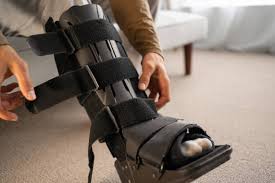Side Effects of Wearing a Walking Boot

Walking boots are prescribed for those with ankle or foot injuries to help them recover. They provide support and protection while allowing some mobility. However, wearing a walking boot isn’t without its downsides. Understanding the possible side effects of wearing a walking boot can help you manage your recovery better and avoid new problems.
Common Physical Side Effects of Wearing a Walking Boot
While walking boots aid healing, they also cause some common physical issues. These include skin irritation, muscle weakness, and joint stiffness.
Skin Irritation and Pressure Sores
Wearing walking boots leaves your foot wrapped for hours or days, creating a warm, moist environment. This can lead to skin irritation and pressure sores. Moisture buildup combined with friction can cause redness, itching, and sometimes open wounds.
An improper fit makes things worse. Boots that are too tight press unevenly, while loose boots allow excessive movement inside, both increasing the risk of sores.
Preventive tips:
· Keep the skin dry and clean.
· Use moisture-wicking socks.
· Check the foot daily for any red or painful spots.
· Adjust or refit the boot with your healthcare provider if discomfort lasts.
Muscle Weakness and Atrophy
Immobilizing your foot limits muscle use. Over time, this can lead to muscle weakness or atrophy, especially in the calf and thigh muscles. When muscles aren’t regularly used, they shrink and lose strength.
To prevent significant muscle loss, incorporating physiotherapy or simple leg exercises (as your doctor suggests) is important. Regaining muscle strength speeds up your return to normal activity.
Reduced Range of Motion and Joint Stiffness
Keeping the ankle still reduces its movement, causing joint stiffness. After long immobilization, you might notice difficulty bending or rotating your ankle as before. This decline in mobility can contribute to longer-term joint pain or problems if not addressed with proper rehabilitation.
Biomechanical and Gait Alterations
Wearing walking boots change how one walks and hold their posture. The boot’s design affects leg length and movement, creating imbalances that ripple through your body.
Limb-Length Discrepancy and Its Effects
Walking boots often have thick soles, making that leg effectively longer while you wear it. This difference creates a limb-length discrepancy, causing your pelvis to tilt unevenly and possibly leading to spinal misalignment.
This uneven stance can create pain and tightness in other parts of the body as it tries to adjust.
Secondary Site Pain: Back, Hip, and Knee Discomfort
The shift in posture and gait from walking boots often causes soreness beyond the foot or ankle. Many users report new pain in their lower back, hips, or knees. This happens because the joints and muscles compensate for the uneven leg length and altered walking pattern.
According to research shared by Tayco Brace, these secondary pains are among the less obvious but serious concerns when using walking boots.
Impact on Balance and Risk of Falls
A walking boot can also affect your balance. The heavier weight and changed walking mechanics reduce stability, increasing your risk of stumbling or falling. Being cautious while moving on uneven ground or stairs is important when wearing one.
Health Risks and Complications Associated with Walking Boots
Beyond physical discomfort, some health risks come with wearing a walking boot.
Risk of Blood Clots and Circulation Issues
Limited movement and immobilization can slow blood flow in your leg. This may lead to a increase in blood clots (deep vein thrombosis). Symptoms to watch for include swelling, warmth, redness, or pain in your calf.
If you notice these signs, seek medical advice promptly. Your doctor might recommend gentle leg movements or compression stockings during recovery.
Skin Infections and Hygiene Challenges
The same moisture and skin issues that cause irritation can lead to infections. Poor hygiene inside the boot, especially with wounds or sores, could invite bacteria, leading to serious complications.
Cleaning routines and proper boot maintenance are key to preventing infection.
Sleep Disturbances and Discomfort
Sleeping with a walking boot can be uncomfortable. Its bulkiness and heat retention often disturb sleep quality. You might feel restless or find it hard to get comfortable, affecting your overall recovery.
Long-Term Effects of Prolonged Boot Use
Extended use of a walking boot beyond its recommended period can cause more serious problems.
Persistent Musculoskeletal Pain and Joint Degeneration
Long-term alteration in gait and posture may lead to chronic pain in hips, knees, or the lower back. This constant abnormal stress on joints can accelerate wear and tear, potentially leading to joint degeneration.
Bone Demineralization and Weakness
Not bearing weight normally reduces bone strength, a condition known as disuse osteopenia. As a result, the bones become more fragile and susceptible to fractures once you resume regular activity.
Recommendations to Minimize Long-Term Effects
- Use the walking boot only as long as advised by your healthcare provider.
- Engage in physiotherapy to maintain muscle function and joint mobility.
- Consider alternative supportive devices or customized orthotics once healing progresses.
Conclusion
Wearing a walking boot is essential to healing, but it comes with side effects such as skin irritation, muscle weakness, gait changes, and risk of complications like blood clots. Being aware of these issues helps you tackle them early. Proper care, timely physiotherapy, and regular consultation with your healthcare provider are key to a smoother recovery and avoiding long-term problems.
Are you wondering if a pair of walking boots is good for you? Consult with Diana Rangaves, a professional clinical consultant. She will offer you the right advice.



